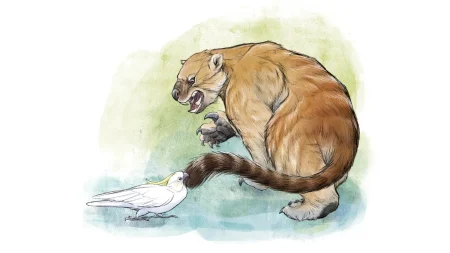Bright Orange Lichens: Nature’s Signposts to Dinosaur Treasures
In the rugged badlands of western Canada, an unexpected alliance between ancient fossils and tiny organisms is revolutionizing how paleontologists discover dinosaur remains. Two species of orange lichen have developed a curious preference for making their homes on dinosaur bones rather than surrounding rock, creating a natural beacon that can guide researchers to new fossil sites.
Researchers led by paleontologist Brian Pickles from the University of Reading in England have discovered that these vibrant orange lichens – Rusavskia elegans and Xanthomendoza trachyphylla – demonstrate a remarkable selectivity in their habitat choices. “Rather than finding new sites serendipitously, this approach can help paleontologists to locate new areas that are likely to have fossils at the surface and then go there to investigate,” explains Pickles. This selective relationship between lichens and fossils isn’t entirely new to scientists; paleontologists working in western North America’s desert fossil hotspots have long noticed orange lichens covering dinosaur bones. As far back as 1922, researchers discovered an Ankylosaurus fossil adorned with orange lichen in the Canadian badlands, and similar observations were made of a Centrosaurus bonebed in 1979.
What makes lichens such interesting organisms is their fundamental nature as symbiotic partnerships between fungi and algae or cyanobacteria. These resilient life forms thrive in challenging environments and display remarkable habitat specificity. “Lichens tend to be quite picky about where they grow,” notes AJ Deneka, a lichenologist at Carleton University who wasn’t involved in the research. “Species that grow on granite do not grow on sandstone or limestone and species that grow on wood don’t grow on rock.” This selectivity extends to fossil bones, which seem to offer ideal conditions for certain lichen species. Deneka suggests that “the porous texture of fossils probably plays a role in making them a suitable lichen habitat, perhaps by retaining moisture or providing tiny pockets where lichen can become trapped and established.”
The research team took their investigation to the next level by measuring the light frequencies reflected by rocks, bones, and the bone-inhabiting lichens in Dinosaur Provincial Park, Alberta. Their spectral analyses revealed that these lichens primarily reflect specific infrared light frequencies, which led to an innovative application. The researchers developed drone sensors calibrated to detect these particular light signatures from above. Testing proved remarkably successful, with the team able to identify fossil bonebeds from a height of 30 meters. “We could only locate the fossils thanks to the lichen association,” Pickles emphasizes, highlighting how this biological relationship is transforming fossil hunting methodology.
This drone-based detection technique holds tremendous potential for paleontological exploration, particularly in remote or challenging terrain. Renato García, a paleontologist at Universidad Nacional de Avellaneda who wasn’t involved with the study, believes the approach “has great potential for use in little-explored or difficult-to-access areas.” García’s own research has uncovered similar relationships between certain lichens and fossil penguin bones in Antarctica, suggesting this methodology could be applicable across various regions and fossil types. The discovery represents a perfect example of how interdisciplinary approaches—combining biology, paleontology, and modern technology—can open new avenues for scientific discovery.
Looking ahead, Pickles and his team are eager to expand their research to other badland regions, where similar lichen-fossil relationships might exist. Their work, published in the journal Current Biology on November 3, demonstrates how nature often creates its own indicators of hidden treasures. By recognizing and leveraging these natural signposts, scientists are developing more efficient and targeted approaches to uncovering Earth’s prehistoric past. This harmonious relationship between tiny, colorful organisms and the massive remains of dinosaurs that roamed the planet millions of years ago reminds us that in science, sometimes the smallest clues can lead to the biggest discoveries.















